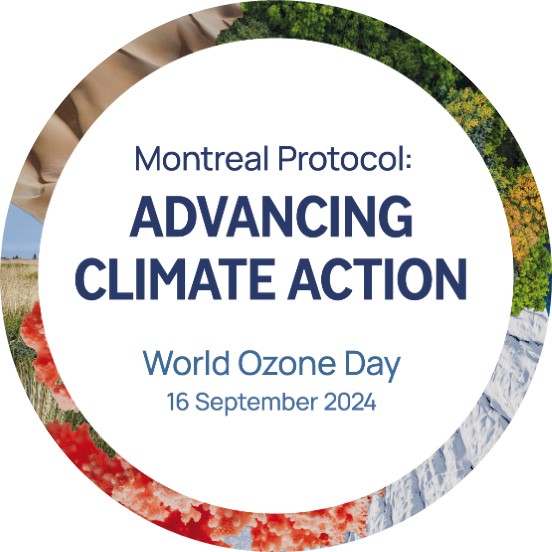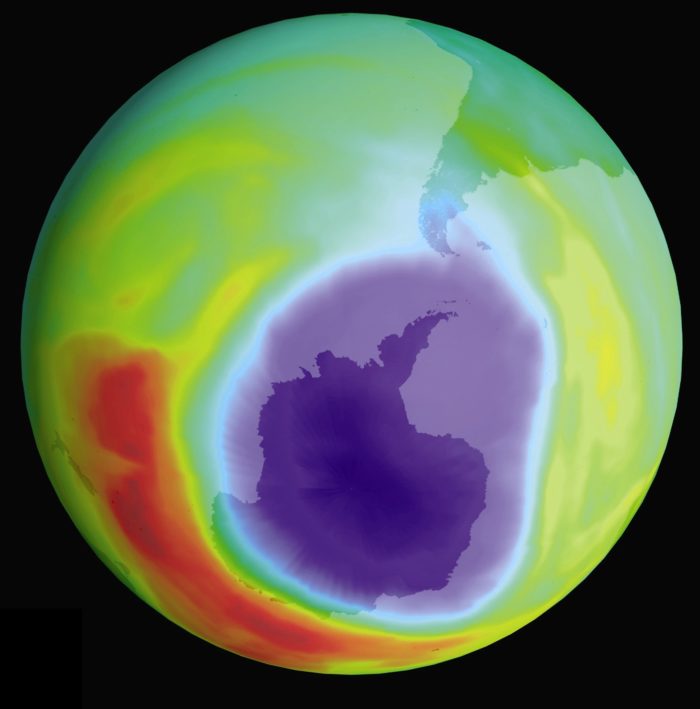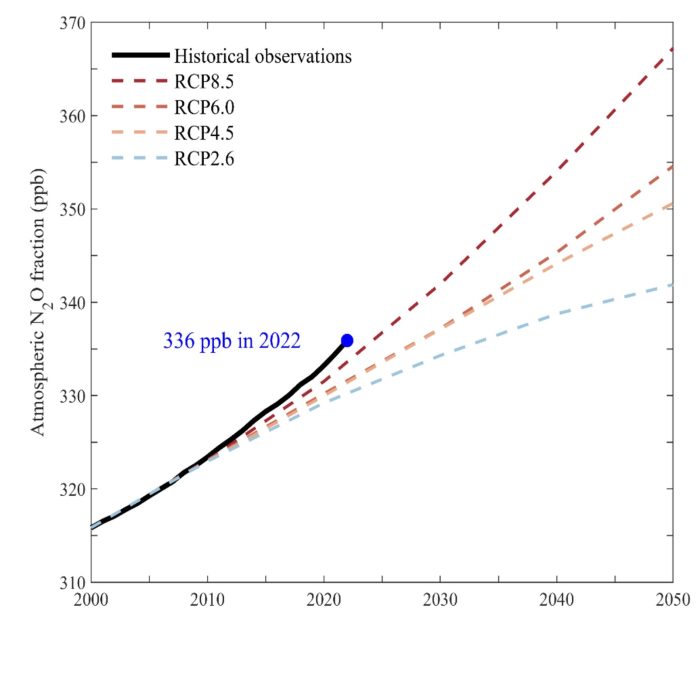World Ozone Day 2024 — exploring the link between ozone protection and climate action



The protection and ongoing recovery of the ozone layer, secured through action under the Montreal Protocol, is perhaps the greatest example we have of the global community coming together to address a critical global environmental challenge.
World Ozone Day (16 September) is an opportunity to celebrate this success, but also to remind ourselves that Earth’s life support systems are fragile and can’t be taken for granted.
On World Ozone Day 2024, we look at the links between ozone and climate, celebrating the role that the Montreal Protocol has already played in advancing climate action and exploring its potential to offer even greater benefits in the future.

The ozone layer acts as a protective shield for Earth, blocking harmful solar radiation from reaching the surface of the planet. Without this layer in the stratosphere, exposure to high levels of ultraviolet (UV) radiation would make life here impossible.
As well as being seriously harmful to human and animal health, excess UV radiation also damages plant life and even soil health. This damage reduces the capacity of our natural ecosystems to store carbon, which instead accumulates in the atmosphere as carbon dioxide (CO2), contributing to the already accelerating increase in global temperature.
And this is not the only link between the ozone layer and climate change …
During the 1970s, before there was widespread public awareness of the impending climate emergency, scientists began to raise concerns that the ozone layer might be under threat from man-made chemicals known as chlorofluorocarbons (CFCs). CFCs were used in thousands of products worldwide at the time, especially in refrigeration equipment, aerosol sprays and insulation foams.
Growing evidence indicated that chlorine in these CFCs could destroy the ozone molecules in the stratosphere, depleting the ozone layer and exposing the planet to higher levels of UV radiation.

Hole in the ozone layer over Antarctica, 1998 (c) NASA
After scientists discovered a significant hole in the ozone layer above Antarctica, the international community came together in 1987 to agree the Montreal Protocol, a treaty to protect the ozone layer by phasing out CFCs and other ozone-depleting substances (ODS).
It would eventually become clear that the Montreal Protocol didn’t just benefit the ozone layer, however. CFCs and other ODS addressed under the Protocol, including the subsequently phased out hydrochlorofluorocarbons (HCFCs), are also potent greenhouse gases with global warming impacts often hundreds or thousands of times more powerful than CO2.
By phasing out the use of these gases, the Montreal Protocol was not just protecting the ozone layer, but also the planet’s climate system. In fact, scientists have estimated that without the Montreal Protocol, annual emissions of these ODS could have increased to the equivalent of 18 billion tonnes of CO2 per year by 2010, roughly equal to half of all actual CO2 emissions that year.
And the climate benefits of the Montreal Protocol don’t stop there. In 2016, the Protocol was further strengthened by the signing of the Kigali Amendment, which saw countries agree to phase-down their use of hydrofluorocarbons (HFCs).
HFCs are another man-made chemical, developed by fluorochemical companies to replace their previous CFC and HCFC products. HFCs are ozone-friendly, but as powerful greenhouse gases they are seriously damaging to the climate. The adoption of the Kigali Amendment was a recognition of the climate impact these ODS replacement gases were having and it cemented the Montreal Protocol as being not just an ozone treaty, but a climate treaty too.

Since the signing of the Montreal Protocol in 1987 and its strengthening with the Kigali Amendment in 2016, the world has made great progress towards phasing out the most damaging ODS and controlling the powerful greenhouse gases that often replaced them. It is important to recognise this success, which serves as a timely reminder of the importance of collective global action.
Widely hailed as the world’s most successful international environmental treaty, the Montreal Protocol has today phased out more than 99 per cent of the production of controlled ODS, ensuring that the ozone layer remains on the path to recovery. This phase-out will also have avoided between 0.5°C to 1°C in additional global warming from ODS emissions by 2050.
With the HFC phase-down under the Kigali Amendment projected to avoid a further 0.3°C to 0.5°C of additional warming by mid-century, the Montreal Protocol is significantly contributing to limiting warming to well below 2°C (the all-important target of the 2015 Paris Agreement).
But threats to both the ozone layer and the climate system remain and there are significant ways in which the Montreal Protocol can be bolstered to protect its legacy and continue advancing climate action, in addition to the big challenge of implementing the Kigali Amendment.
Nitrous oxide: Nitrous oxide (N2O) is both an ODS and a greenhouse gas, a threat to both the ozone layer and the climate. And N2O is not just any ODS or greenhouse gas; it’s the most prevalent ODS in the world today and the third most significant greenhouse gas.
Since 1980, human emissions of N2O have increased by 40 per cent, which is faster than even the most alarming predictions. The largest source of these emissions is agriculture, which accounts for about two-thirds of all human-produced N2O emissions, but other important sources also include the chemical industry, transport, biomass burning and wastewater.

Figure: Levels of N2O measured in the atmosphere (parts per billion–ppb), compared to previously projected scenarios. (Tian et al, 2024)
EIA believes that the Montreal Protocol has an important role to play in tackling emissions of N2O, primarily by focusing on emissions from chemical industrial sources. By agreeing a pathway to secure action on industrial N2O emissions, the Montreal Protocol could take the first meaningful steps towards reducing emissions of this climate-damaging ODS.
ODS and HFC banks: The stores of ODS and HFCs contained in old equipment and products are known as ‘banks’. Historically, emissions from banks have never been addressed under the Montreal Protocol, even though they represent a serious ozone and climate threat. In fact, it has been estimated by the Montreal Protocol’s Scientific Assessment Panel that the collection and destruction of CFC banks alone would be “the single most effective ozone depletion and climate change mitigation option” for ODS.
One major issue in addressing banks is the lack of data establishing clearly where they are and how much they are emitting. That’s why EIA is pushing for a global framework to recover and destroy ODS and HFC banks, which we believe should include a key role for the Montreal Protocol. As a positive step in this direction, funding has now been offered to developing countries under the Protocol to help them draw up national inventories of banks and to begin planning for how to dispose of them safely and effectively.
Feedstocks and production emissions: A feedstock is a chemical building block used to manufacture other chemicals. The production and use of feedstocks and unwanted byproducts in fluorochemical production processes are exempt from the Montreal Protocol’s phase-out, based on an assumption that there are minimal emissions — an assumption now challenged by a growing body of scientific evidence.
Based on EIA’s review of the available published research, we estimate that annual fluorochemical production-related emissions are equivalent to 492 million tonnes of CO2 – this is more than the total greenhouse emissions reported each year by most countries in the world, including the UK and France.
Since the most common feedstocks are ODS as well as greenhouse gases, these emissions are also hindering ozone layer recovery. It is therefore imperative that Parties to the Montreal Protocol find a way to address emissions from the fluorochemical production sector, which despite the successful ODS phase-out, continues to wreak devasting impacts on our environment.
The theme for World Ozone Day 2024 is ‘Advancing Climate Action’. This is a fitting theme because in many ways ozone action is climate action and the Montreal Protocol in particular has a proud legacy in advancing both – even if there is always more work to do.
Perhaps the best lesson we can learn from the Montreal Protocol is that when countries come together with a common purpose, even the most difficult environmental problems can be overcome.